Research themes of Team CPCP
Project 1 : Synthesis of copolymer with a controlled and complex architecture
1 - Nouveaux amorceurs hétéromultifonctionnels. Nouvelles voies d’accès à des copolymères à blocs et en étoile de type A2B, A2B2 et A3BBien que toutes les méthodes de synthèse de copolymères diblocs et en étoile aient largement contribué à l’obtention de structures de compositions et d’architectures différentes, elles ne sont pas adaptées à toutes les natures chimiques de monomères. Une alternative est l’utilisation d’amorceurs hétéromultifonctionnels qui sont capables d’amorcer la polymérisation de deux ou plusieurs monomères, à partir des fonctions différentes qu’ils portent, sans avoir recours à des étapes de fonctionnalisation intermédiaires, ce qui permet d’élargir la gamme de monomères pouvant être polymérisés.
- Synthèse de copolymères diblocs par voie simultanée
Différentes équipes ont étudié l’utilisation d’un amorceur hétérobifonctionnel pour la synthèse par voie séquentielle de copolymères diblocs par couplage de différents modes de polymérisations. En revanche, très peu de travaux ont étudié ce type de synthèse par voie simultanée qui est une voie très exigeante et contraignante. Plusieurs conditions doivent être requises, à savoir :
- l’amorceur hétérobifonctionnel doit être capable d’amorcer indépendamment et simultanément deux voies de polymérisation différentes avec deux systèmes catalytiques compatibles et sans interférences.
- les monomères doivent polymériser avec deux modes de polymérisation différents et indépendamment l’un de l’autre dans le même solvant et à la même température.
- les cinétiques des polymérisations doivent être comparables.
A partir d’un amorceur hétérobifonctionnel développé au laboratoire (comportant une fonction alcool et un brome labile), des copolymères diblocs PCL-b-PtBuMA de masses molaires et de compositions variées, tous bien définis (Ip<1,3), ont été obtenus en couplant simultanément la polymérisation anionique coordinée de l’e-caprolactone en présence de triéthylaluminium (TEA) et l’ATRP du tBuMA. En jouant sur la vitesse de polymérisation de l’e-caprolactone (i.e. sur le rapport alcool/TEA), nous avons obtenu un système de polymérisations simultanées contrôlable et ce, pour la première fois. En faisant varier ces deux facteurs, il est ainsi possible de prévoir la composition du copolymère et la masse molaire de chacun des blocs.
- Synthèse de copolymères en étoile
La mise au point de nouveaux amorceurs hétéromultifonctionnels a permis l’obtention de copolymères en étoile de type A2B, A2B2 et A3B par amorçage séquentiel ou simultané de deux polymérisations contrôlées. Ces amorceurs, issus de diols, triols ou tétraols, possèdent un ou plusieurs bromes labiles capables d’amorcer l’ATRP d’un premier monomère, ainsi qu’une ou plusieurs fonctions alcools capables d’amorcer par voie anionique ou anionique coordinée la polymérisation d’un hétérocycle (lactone ou oxirane). A titre d’exemple, la synthèse d’un amorceur hétérotrifonctionnel est présentée sur le schéma 1.
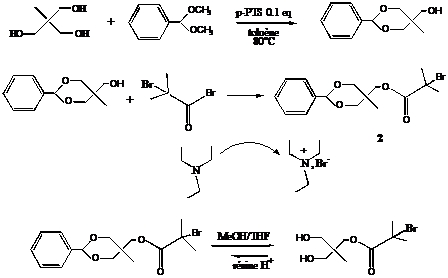
Schéma 1 : Synthèse d’un amorceur hétérotrifonctionnel
A partir de ces nouveaux amorceurs, des copolymères en étoile tels que (PCL)2-arm-PS, (PCL)2-arm-PtBuMA, (PCL)2-arm-PMMA, (PtBuMA)2-arm-PCL, (POE)2-arm-PS et leurs équivalents à 4 bras, (PCL)2-arm-(PS)2 et PCL-arm-(PtBuMA)3 … ont été obtenus et ce, de façon contrôlée. Plus récemment, nous avons également obtenu, et ce pour la première fois, des copolymères PS(POE)3.
2 - Synthèse de nouveaux copolymères à blocsLa synthèse de copolymères à blocs comportant des blocs poly(acétate de vinyle) (PVAc), poly(vinyl alcool) (PVA) et poly(e-caprolactone) (PCL) a été réalisée par combinaison de la RAFT, de la ROP et de la chimie « click ». Deux voies d’accès à ces copolymères ont été développées :
- la voie du « starting from » : des macroamorceurs PCL comportant une fonction xanthate capable de réamorcer la polymérisation d’un second monomère par RAFT ont été synthétisés (schéma 2).
- la voie du « grafting to » : des homopolymères PVAc, PCL, PVA comportant soit une fonction alcyne, soit une fonction azide ont été synthétisés puis couplés entre eux par chimie « click » (schéma 3).
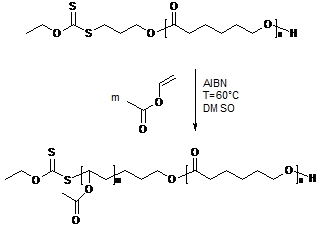
Schéma 2 : Copolymère à blocs PCL-b-PVAc obtenu par la méthode du macroamorceur
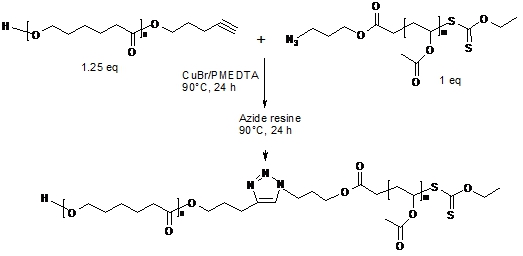
Schéma 3 : Copolymère à blocs PCL-b-PVAc obtenu par chimie « click »
Des copolymères à blocs bien définis, de masses molaires et de compositions variables ont ainsi été obtenus et ce, quelque soit la méthode.
Synthesis of PCL-b-PVAc block copolymers by combination of click chemistry, ROP, and RAFT polymerizations
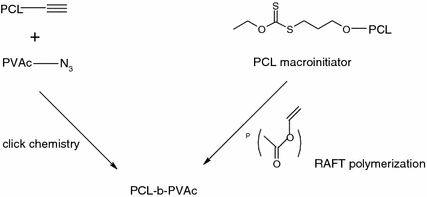
The synthesis of new poly(ε-caprolactone)(PCL)-b-poly(vinyl acetate)(PVAc) block copolymers was investigated using different combinations of click chemistry, reversible addition-fragmentation transfer (RAFT), and ring opening polymerization (ROP) techniques. Two approaches, “coupling” and “macroinitiator” routes were studied. For the coupling approach, a chain transfer agent comprising an azide function was synthesized and used as initiator for the VAc polymerization. PCL containing an alkyne termination was obtained from a bifunctional initiator bearing an alkyne function and an hydroxyl group. These two functionalized precursors, PVAc and PCL, were coupled by a 1,3 cyclo addition reaction “click chemistry” in order to obtain the corresponding block copolymer. For the macroinitiator approach, PCL-b-PVAc block copolymers were synthesized using a two-step procedure: at first, a PCL macroinitiator with a xanthate end group was prepared by coordinated anionic polymerization of ε-caprolactone; then, the RAFT polymerization of VAc was initiated from the PCL, for the preparation of PCL-b-PVAc block copolymers. Whatever the method used, no detectable quantities of unreacted PVAc or PCL were observed. 1H NMR and size exclusion chromatography analyses indicated successful synthesis of the block copolymers with well-defined structures.
Personnel: Glaied Olfa; Delaite Christelle; Riess Gerard
Source: POLYMER BULLETIN, 2012, Volume: 68 Issue: 3 Pages: 607-621
Crystallization kinetics of PCL tagged with well-defined positional triazole defects generated by click chemistry
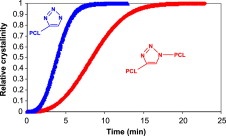
Well-defined poly(caprolactone) PCL samples of narrow molecular weight distribution, tagged with a triazole junction in predetermined position of the chain, were synthesized by an alkyne-azide click reaction. The crystallization kinetics of these original PCL’s, having a triazole “defect” in central position or at the chain end, were investigated by WAXD and by differential scanning calorimetry (DSC) under nonisothermal and isothermal conditions. Major kinetic differences could be observed between the triazole end-capped PCL and the one having a triazole “defect” in central position of the chain. The crystallization rate is highest for the triazole end-capped PCL, whereas a PCL with a triazole junction in more central position forms irregular shaped spherulites and is characterized by a longer induction period, a lower crystallization rate and a reduced maximum melt temperature. Its thermostability as demonstrated by thermogravimetry analysis TGA, is however increased with respect to the corresponding triazole end-capped sample.
Personnel: Atanase Leonard I.; Glaied Olfa; Riess Gerard
Source: POLYMER, 2011, Volume: 52 Issue: 14 Pages: 3074-308
Synthesis of ABC miktoarm star block copolymers from a new heterotrifunctional initiator by combination of ATRP and ROP
We described the obtention of well-defined ABC star block copolymers through the use of a new heterotrifunctional initiator. That way, well-defined PCL-arm–PS-arm–PLLA star block copolymers have been synthesized from a heterotrifunctional initiator bearing two hydroxyl groups able to initiate ROP of CL and LLA (using Sn(Oct)2 as coinitiator) and a bromide function able to initiate ATRP of styrene.
Personnel: Gordin Claudia; Delaite Christelle; Medlej Hussein
Source: POLYMER BULLETIN, 2009 Volume: 63 Issue: 6 Pages: 789-801
